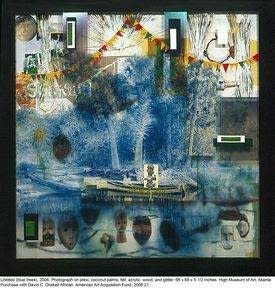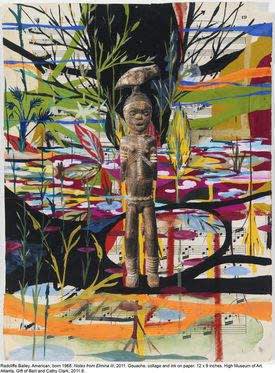Sebaastian Smee for The Boston Globe - 24 February 2012
Covering most of the floor in a gallery at the Davis Museum at Wellesley College, “Windward Coast,’’ an installation by Radcliffe Bailey, is a pile of 35,000-odd wooden piano keys with black and white tips, extracted from 400 pianos.
The pile has been spread out and shaped into a vast rectangle. Its edges are neat, but inside those edges it undulates, conjuring a turbulent, wind-whipped sea. Nothing relieves the rhythmic motion of these rough and splintered piles of wood (they feel like a sculptural equivalent of cross-hatching, or perhaps a giant game of Pick Up Sticks), except for a sculpted head, covered in black glitter, emerging from the waves of wood.
A conch shell is also attached to a corner wall. It emits a percussive sound, an audio recording of the artist dropping the pieces of wood as he constructed the work.
For Bailey, an African-American who was born in 1968 and is based in Atlanta, the piece - like all his work - triggers many possible meanings. It evokes, most immediately, the slave trade and the “Middle Passage,’’ a term used to describe the thousands of ship voyages that transported slaves from the west coast of Africa to the Americas.
But it may also evoke other historical disasters, from Hurricane Katrina to the tsunami that recently wrought such havoc in Japan, both of which Bailey has said he had in mind when he created the piece, between 2009 and 2011.
It suggests, too, more private meanings for Bailey - specifically, the fishing trips he made with his father as a boy when, sitting in a boat far from shore, he felt, he has said, “so small.’’
And of course, through the piano keys, the piece suggests the historical continuity of music, a recurring trope in Bailey’s work, which is always to some degree about memory, both personal and historical.
“I see myself as a vessel, and things come through me,’’ the artist said in a talk he gave in Atlanta last year.
The piece is the highlight of an impressive survey of Bailey’s work called “Memory as Medicine,’’ which comes to the Davis from the High Museum of Art in Atlanta. It’s one of a series of shows devoted to African-Americans in Massachusetts this winter, ranging from “African Americans and the American Scene, 1929-1945’’ at the Williams College Museum of Art to “In Search of Julien Hudson, Free Artist of Color in Pre-Civil War New Orleans’’ at the Worcester Art Museum, “Sanford Biggers: The Cartographer’s Conundrum’’ at the Massachusetts Museum of Contemporary Art, and “We Are the Ship: The Story of Negro League Baseball’’ at the Eric Carle Museum of Picture Book Art (see story on Page 10).
(Both Bailey and Biggers, it’s interesting to note, cite as a major influence Sun Ra, the jazz composer, keyboard player, and cosmic philosopher who claimed he was from Saturn.)
Not every work in “Memory as Medicine’’ is as successful or striking as “Windward Coast.’’ But Bailey is never less than ambitious. And what stands out above all else is the jazzy, improvisational inventiveness of his work, each piece’s extraordinary richness of connotation.
This richness is a result of the way Bailey likes to layer his work, so it reveals itself slowly, like a palimpsest or archeological dig. Occasionally, the promiscuity of each work’s personal, political, and poetic references overwhelm the forms he finds to contain them.


